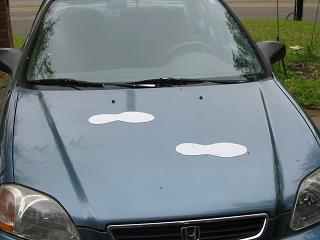I still like the vertical design, but I think I need a more suitable plant for it. Maybe aloe.
Recent progress includes moving my nasturtiums and sunflowers to the front yard. I had tried twice to start nasturtiums from seed and each seed packet yielded only two sprouts. They are spindly and small. I hope they survive to flower. Nasturtiums are annuals and are reputed to deter white flies. I planted them at the base of my persimmon tree which has been very susceptible to white flies in the past.
I had similarly bad yield with my giant sunflowers. I have three surviving sprouts now in a pot in the front yard where they should get the most sun. They are spindly and not growing quickly.
A person at work gave me several aloe plants about three inches high. I planted them in a new bed in the front yard that is made up of compost and reclaimed silt that had pooled at the end of the block near the drainage ditch. Something is burrowing in this soft, sandy patch and the aloe plants have slowly disappeared. I started with a dozen and only one remains.
To deter whatever was burrowing, I planted several garlic cloves. It seems I planted too little too late.
When I bought the house, two large planters full of aztec grass that I ignored. It's hardy stuff but it doesn't feed me and it's not particularly attractive. I was able to pull up the whole pot of soil by the massive rootball and flip it. I planted garlic in the bottom just to see how well it would work. The garlic sprouted in a week and when the tops die and fall over I should have a new crop of bulbs that I can harvest and dry and then replant one or two bulbs for another crop.
I continued work on the big leaf pile, which is now almost at capacity. I need to begin a regular watering routine and start turning it. I just purchased my garden fork for this purpose.
I finally put some tomatoes in the ground. I need to add some additional trellising in the center of the garden beds. I tried a new technique with a couple of the tomato plants. They were about 18 inches long. I dug a trench in the soil about four inches deep and planted the majority of the stem in the trench--horizontally. So only the last four inches or so of the plant sticks above ground, perpendicular to the rest of the plant. The idea is that since the tomato plant can root from the stem, having more of the plant in the ground will make the plant stronger and make it grow better. In the same bed I have other varieties planted the conventional way, well the way I conventionally do it. I start the from seed, get them a foot long or so and plant them as deeply as I can (six or eight inches). They are not all the same variety, so not all variables are controlled but I should be able to compare the success of the plants.
I have volunteer squash plants popping up in a lot of places. I don't know what variety they are though they are likely pumpkin or butternut. I know that my Earth Machine has not been composting hot, so seeds remain in that soil and
are getting mixed in with my potting mix. I have moved the volunteers to a single, crowded pot. Once the vine borer adults have come and gone I will try to transplant them into one of the beds.
